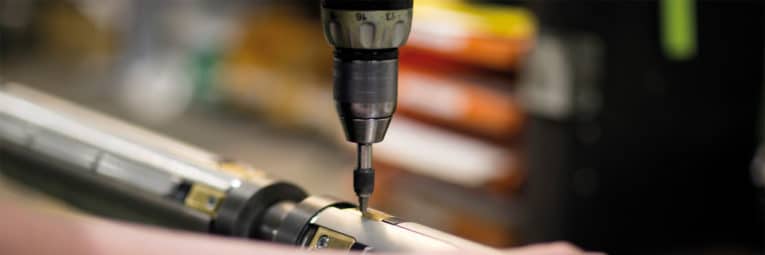
- Home
- All Posts
- Rewinding Technology
- Locked Core or Differential Rewinding
Blog

Locked Core or Differential Rewinding
The common types of rewinding method include locked-core winding and differential winding. Locked-core method is a cost-effective solution for a wide range of converting industries, utilize an air expanding shaft to transmit a constant winding torque to all rolls. Differential method is much more complex and relative expensive, differential controlled slip shafts have various designs to maintain the equal tension on multiple rolls. Engineers from LEAP decide the winding structure based on the specifiacations and properties of the coil materials.
Locked-core rewinding method
The cores are locked onto a winding sharft, and fixed by air expanding lug or strip. The linear velocity of web material on the winding shaft keep synchronous with motor speed. Locked-core method is widely used for rolls with large diameters and large widths, especially appropriate for rewinding a full width roll without slitting. It’s frequently applied on surface winder where the rewinding shaft isn’t driven from its center. Mechanical lug shafts are designed with powerful expansion mechanism, and provide great gripping force on cores to handle the heavy roll weights at high speeds, it has many advantages of high efficiency, simple structure, low cost, convenient unloading, etc.
However, locked-core winding manner has many limitations for some materials which are easily damaged when stretched. In winding process, it’s difficult to guarantee all the rolls have same diameter due to the accumulation of web thickness error, that means some rolls may wind too loose and some rolls may wind too tight. This difference can result in various quality issues including roll telescoping, broken, starring, weaving, crushed wraps, etc. Besides, the quantity of winding rolls is another factor. Generally the more rolls being wound on the winder, the greater the error is obtained. When this inconsistency exceeds acceptable level, the coils can not even be reeled.
Differential rewinding method
As mentioned above, winding multiple rolls of material on a single shaft can greatly improve production efficiency. But this approach may cause unwinding and rewinding issues because each roll will turn at the same centre rate. Most of the materials which are converted have tiny variations in thickness. After slitting process, strips are wound onto the rewinding shafts, difference in each roll’s diameter start to develop along with increasing number of layers are wound. In this case, major web tension will be delivered to the larger rolls. That means the larger diameter of material would wind tightly while the smaller diameter of material would wind loosely. In order to eliminate these differences, different rotational speeds are required to keep the same surface speed and also maintain the consistent web tension.
Differential air shafts can help you to maintain equal tension on multipul rolls. Cores are gripped by friction rings which run on a central shaft, individual rewinding rolls aren’t completely locked onto the winding shaft and they are allowed to slip relative to one another, the tension ranges of the shafts are adjustable by changing the expanding strip material of the centre shaft which offers the slippage. This is known as “differential winding”. Each wound roll is driven from its center at a different speed to maintain a consistent outer surface speed. This method can help each independent roll run at appropriate speed and tension and realizes high-quality rewinding of web materials which have non-uniform gauge by varying the torque applied to the core. Differential rewinding technology is commonly utilized in applications of center-winding slitter rewinders.
About Lvjie
1 Comment
Leave a Comment
Serch
Recent Posts
-
Overview of UHMWPE Separato... September 20, 2024
-
Overview of PVC Slitter Rew... July 2, 2024
-
Overview of Pre-coated Film... April 25, 2024
-
Overview of stretch film sl... March 11, 2024
-
Application of BOPP Tape Sl... November 29, 2023
Categories
- All Posts (28)
- Others (1)
- Unwinding Technology (3)
- Rewinding Technology (7)
- Slitting System (18)
- Control System (4)
Contact Info

Xiongzhou Street, Liuhe District, Nanjing City, 211511, China
Phone: 86 025 86555699Email: info@film-slitter.com
Recent Posts
-
Overview of UHMWPE Separato... September 20, 2024
-
Overview of PVC Slitter Rew... July 2, 2024
-
Overview of Pre-coated Film... April 25, 2024
-
Overview of stretch film sl... March 11, 2024
-
Application of BOPP Tape Sl... November 29, 2023

The primary differential winding torque is created by the shaft s frictional slip clutching mechanism. A clutch is any device that engages or disengages a rotating shaft and a driving mechanism. A slip clutch is a clutch in that when you engage it, instead of locking gears together like a car s clutch, loads two non-locking surfaces together. By controlling the load between the two slipping surfaces, you control the friction-limited force that develops when the clutch slips. Most differential shafts have their torque regulated by air pressure, either the air pressure that pushes laterally on a stack of slipping cores and locked spacers or that pushes radially from an internal bladder out against slipping elements or the core s inner diameter. As you apply more pressure, the clutching mechanism will slip at a higher frictional force and a winding roll will receive more torque. The torque applied at the core then is transmitted out through the radius of the winding roll to create tension at the roll s outer diameter.